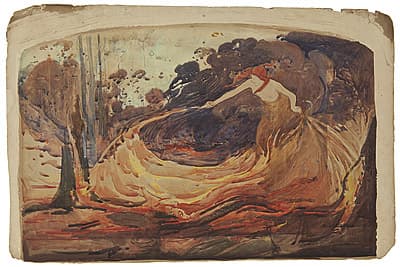Sydney
LONG
Australia
1871
–
London
1955
England, Europe 1910-21; Australia 1921- 22; England 1922-25; Australia 1925-52; England from 1952
30.8 (h) x 46.7 (w) cm
signed and dated ‘SID LONG/ 1900’ lower right Collection: Art Gallery of Ballarat Art Gallery of Ballarat, purchased 1977
Long demonstrated his interest in visualising the forces of nature in the bush in 1897 with The Spirit of the plains (cat 9) and then, in 1898, with Pan (cat 11). Charles Conder had previously done so in his allegorical image Hot wind 1889 (NGA), and Arthur Streeton in The Spirit of the drought c 1896 (NGA).
In The Spirit of the bushfire,Long depicted a destructive natural force, the bushfire, one of Australia's most feared natural phenomena. He showed the Spirit of the bushfire with flowing, flame coloured hair, waving her wand of fire.
This Spirit is a fin de siècle femme fatale, like the women in the symbolist works of Conder and Streeton, she is an evocation of a powerful destructive force. Her twisting, swirling form may derive from the expressive dancing of Loïe Fuller, or from decorative Art Nouveau posters. Nonetheless, in this image, Long used these decorative motifs to powerfully evoke the intense heat of a raging fire rapidly engulfing the surrounding bush.
A few years earlier, about 1897, George W. Lambert had illustrated Jessie Whitfeld’s children’s stories, The Spirit of the bush fire. Lambert’s pen and ink drawings included an illustration for the title story, which describes how the Spirit of the bush fire, aided by the wind, fanned up a raging fire from a spark that had been dropped from a man’s pipe; and how the raindrop elves created a downpour to smother the Spirit. Long, who shared a studio with Lambert from 1895 to 1897, may have been inspired by Lambert’s interest in this theme to create his own version of the subject, believing he could better Lambert’s imagery.
Long demonstrated his interest in visualising the forces of nature in the bush in 1897 with The Spirit of the plains (cat 9) and then, in 1898, with Pan (cat 11). Charles Conder had previously done so in his allegorical image Hot wind 1889 (NGA), and Arthur Streeton in The Spirit of the drought c 1896 (NGA).
In The Spirit of the bushfire,Long depicted a destructive natural force, the bushfire, one of Australia's most feared natural phenomena. He showed the Spirit of the bushfire with flowing, flame coloured hair, waving her wand of fire.
This Spirit is a fin de siècle femme fatale, like the women in the symbolist works of Conder and Streeton, she is an evocation of a powerful destructive force. Her twisting, swirling form may derive from the expressive dancing of Loïe Fuller, or from decorative Art Nouveau posters. Nonetheless, in this image, Long used these decorative motifs to powerfully evoke the intense heat of a raging fire rapidly engulfing the surrounding bush.
A few years earlier, about 1897, George W. Lambert had illustrated Jessie Whitfeld’s children’s stories, The Spirit of the bush fire. Lambert’s pen and ink drawings included an illustration for the title story, which describes how the Spirit of the bush fire, aided by the wind, fanned up a raging fire from a spark that had been dropped from a man’s pipe; and how the raindrop elves created a downpour to smother the Spirit. Long, who shared a studio with Lambert from 1895 to 1897, may have been inspired by Lambert’s interest in this theme to create his own version of the subject, believing he could better Lambert’s imagery.
Long demonstrated his interest in visualising the forces of nature in the bush in 1897 with The Spirit of the plains (cat 9) and then, in 1898, with Pan (cat 11). Charles Conder had previously done so in his allegorical image Hot wind 1889 (NGA), and Arthur Streeton in The Spirit of the drought c 1896 (NGA).
In The Spirit of the bushfire,Long depicted a destructive natural force, the bushfire, one of Australia's most feared natural phenomena. He showed the Spirit of the bushfire with flowing, flame coloured hair, waving her wand of fire.
This Spirit is a fin de siècle femme fatale, like the women in the symbolist works of Conder and Streeton, she is an evocation of a powerful destructive force. Her twisting, swirling form may derive from the expressive dancing of Loïe Fuller, or from decorative Art Nouveau posters. Nonetheless, in this image, Long used these decorative motifs to powerfully evoke the intense heat of a raging fire rapidly engulfing the surrounding bush.
A few years earlier, about 1897, George W. Lambert had illustrated Jessie Whitfeld’s children’s stories, The Spirit of the bush fire. Lambert’s pen and ink drawings included an illustration for the title story, which describes how the Spirit of the bush fire, aided by the wind, fanned up a raging fire from a spark that had been dropped from a man’s pipe; and how the raindrop elves created a downpour to smother the Spirit. Long, who shared a studio with Lambert from 1895 to 1897, may have been inspired by Lambert’s interest in this theme to create his own version of the subject, believing he could better Lambert’s imagery.

